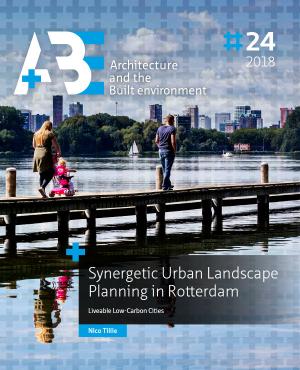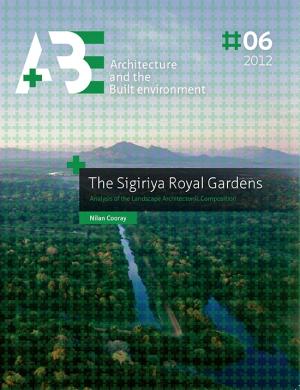Hosted by
Landscape
All Books

This volume delves into the multifaceted aspects of urban governance, preservation, and innovation in the historic city of Kyoto. This collection of essays and research papers offers profound insights and thoughtful analyses into the preservation of urban public goods, historical administration, residential renovation, and community-building in one of Japan’s most culturally rich cities.

How does the ecological thinking affect architects, designers and the design culture itself? The Anthropocene is a geological event, but also a political one that lies in overcoming the idea of crisis. Acknowledging this change means rethinking the very ecology of the project in environmental and atmospheric terms. The changes we face don’t depend on missing balances, but on compromises reached between conservation and exploitation. The Anthropocene...

This book is about the first ten years of the master track in Landscape Architecture at the Department of Urbanism in the Faculty of Architecture and the Built Environment at TU Delft. It delves into the personal, educational, didactical, organizational and, above all, substantive dimensions of the teaching of this appealing and highly relevant discipline at the academic level.
The book has three parts. The first part — PROFILE — discusses the context and events that led up to the...

This publication offers an overview of the latest cross-disciplinary developments in the field of Building with Nature (BwN) for the protection of coastal regions. The key philosophy of BwN is the employment of natural processes to serve societal goals, such as flood safety. The starting point is a systems-based approach, making interventions that employ the shaping forces of the natural system to perform measures by self-regulation. Initial pilots of this innovative approach originate...

This sector portrait of the design engineering sciences describes the common denominator of the various design disciplines in the Netherlands. In a future sector plan, the above investment areas will be further explored and purposefully developed.
The implementation of technological innovations aligned to societal issues encompasses a design challenge. This increasingly demands science-based design methodologies. The broad Dutch design landscape can fulfil the role of connector...

The research of TU Delft’s Faculty of Architecture and the Built Environment (Faculteit Bouwkunde) covers the full spectrum of design, engineering, planning, and management of the built environment. Its research portfolio comprises the research that is conducted by four departments:
- Architecture
- Architectural Engineering + Technology (AE+T)
- Management in the Built Environment (MBE)
- Urbanism
The faculty’s research focusses...

The central question and purpose of the thesis is to understand how landscape as a design concept is changing our understanding of architecture. It explores the ways in which landscape is relevant for design strategies in architecture.
Buildings that have been designed like landscapes have become a topic in contemporary architecture and in the recent literature about it. The apparent distinction between architecture and landscape is questioned in exemplary theoretical works and...

Aim and outline of the research
The aim of this dissertation is to identify and classify the various Holland country houses landscapes based on the most important factors and motives involved in building of the large amount country-houses between 1630 and 1730. The method combines research to tangible and intangible aspects of the spatial designs of country houses and their surroundings. The main research question is: what physical, societal and mental factors...

The role of the designer in flood risk management strategy development is currently often restricted to the important but limited task of optimally embedding technical interventions, which are themselves derivatives of system level flood risk strategies that are developed at an earlier stage, in their local surroundings. During this thesis research, an integrated approach is developed in which spatial quality can already be included in the regional flood risk management strategy...

In this PhD research, the major environmental challenges of our time, such as climate change, sustainable energy transition and scarcity of resources, are approached from a spatial, landscape-architectural perspective. The goal is to accelerate the transition to liveable, low carbon cities. The focus of the research is at the local scale and attempts to turn challenges into opportunities for a better quality of life and living environment. Since 1857, when Frederick Law Olmsted combined...

The Parana River is the third largest river in the American continent, after the Mississippi and the Amazon. Instead of flowing directly to the sea, it flows to the Rio de la Plata (located between Argentina and Uruguay) through a complex delta system. This delta is a large and heterogeneous territory that spreads over three provinces of Argentina and that is characterized by different dichotomies along its extension. On the one hand, the islands of the delta are young alluvial lands in...

This study enlarges on the notion of composition in landscape architecture. It builds upon the ‘Delft method’, which elaborates composition as a methodological framework from its sister discipline architecture. At the same time takes a critical stance in respect to this framework, informed by recent epistemological developments in landscape architecture such as the site-specificity and process discourses. The notion of composition is examined from a historical and theoretical...

This thesis looks at how cities operate as Complex Adaptive Systems (CAS). It focuses on how certain characteristics of urban form can support an urban environment's capacity to self-organize, enabling emergent features to appear that, while unplanned, remain highly functional. The research is predicated on the notion that CAS processes operate across diverse domains: that they are ‘generalized' or ‘universal'. The goal of the dissertation is then to determine how such...

While agglomerations along the Rhine are confronted with the uncertainties of an increasing flood risk due to climate change, different programs are claiming urban river front sites. Simultaneously, urban development, flood management, as well as navigation and environmental protection are negotiating the border between the river and the urban realm. This produces complex spatial constellations between the river system and the urban realm with a diverse set of interdependencies, where...

Improving Institutions for Green Landscapes in Metropolitan Areas investigates how various institutions for green landscapes in metropolitan areas work, which problems hamper them, and how these institutions can be improved. Themes, theories and methods have been selected as a response to the case studies. The following themes were formulated: landscape and institutional developments, the market or government dilemma, the network or hierarchy dilemma, the relation between spatial planning...

Water inSight provides insight into the ‘water machine’ that forms the basis of the Dutch polder landscape. Authors Inge Bobbink and Suzanne Loen approach the polder landscape from a landscape-architectonic point of view, using technical and spatial analysis drawings, images, plans and experiments to visualise the Netherlands and its water system.
Special attention has been paid to polder water, the difference between a peat polder and a lake-bed polder, and the adaptations...

This dissertation argues that the floods following extreme precipitation result notˬonly from very heavy rainfall but also from the significant impact of human activities on natural water systems. While most literature emphasises that the increasing magnitude of storm rainfall extends beyond the original protection standards of hydrologic facilities in highly populated delta cities. Based on the knowledge of urban morphology, this study analyses how human systems have affected the...

This publication provides an overview of TU Delft’s and Berlage’s most significant research achievements in the field of architecture and the built environment, produced over the years 2003—2009. The publication is produced in preparation for the Dutch 2010 research assessment exercise Architecture and the Built Environment.
It is the first joint publication by Architecture, OTB and Berlage and hints clearly at stronger future ties between the three institutes, which are...

Besides the efforts that are of descriptive and celebrative nature, studies related to Sri Lanka’s historical built heritage are largely to view material remains in historical, sociological, socio-historical and semiological perspectives. But there is hardly any serious attempt to view such material remains from a technical-analytical approach to understand the compositional aspects of their designs. The 5th century AC royal complex at Sigiriya is no exception in this regard.
The...

Landscape design research is important for cultivating spatial intelligence in landscape architecture. This study explores GIS (geographic information systems) as a tool for landscape design research - investigating landscape designs to understand them as architectonic compositions (architectonic plan analysis). The concept ‘composition’ refers to a conceivable arrangement, an architectural expression of a mental construct that is legible and open to interpretation. Landscape architectonic...

This publication provides an overview of TU Delft’s most significant research achievements in the field of architecture and the built environment during the years 2010—2012. It is the first presentation of the joint research portfolio of the Faculty of Architecture and OTB Research Institute since their integration into the Faculty of Architecture and the Built Environment. As such the portfolio holds a strong promise for the future. In a time when the economy seems to be finally picking...

Exploring the Visual Landscape is about the combination of landscape research and planning, visual perception and Geographic Information Science. It showcases possible ways of getting a grip on themes like: landscape openness, cluttering of the rural landscape, high-rise buildings in relation to cityscape, historic landscapes and motorway panoramas. It offers clues for visual landscape assessment of spaces in cities, parks and rural areas. In that respect, it extends the long tradition in...

Flowscapes explores infrastructure as a type of landscape and landscape as a type of infrastructure. The hybridization of the two concepts seeks to redefine infrastructure beyond its strictly utilitarian definition while allowing spatial design to gain operative force in territorial transformation processes. The publication provides perspectives on the subject from design-related disciplines such as architecture, urban design, urban planning, landscape architecture and civil engineering....

The Dutch lowlands is an artificial landscape, created as a result of the wish to regulate the water that dominated the topography in the Delta. This ‘confined’ lowland water, the polder-boezem system12, features an enormously diverse range of water structures and forms, which largely dictates the spatial planning of the lower Netherlands.
This dissertation concerns the polder-boezem system, a water system that was created by...

Over the years 2010-2015 TU Delft's Faculty of Architecture and the Built Environment (in Dutch: Bouwkunde or BK) made good progress with its research by:
- merging the Architecture faculty and the Built Environment research institute;
- streamlining its PhD research by setting-up a graduate school for doctoral education;
- co-founding an institute for metropolitan solutions in Amsterdam together with MIT and Wageningen University (targeted yearly budget: 25...
